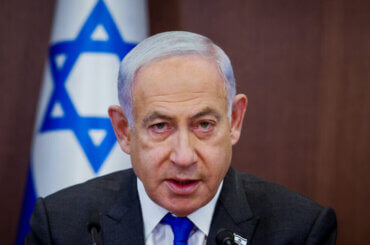This is the blog of Jaron Gilinsky, the guy who did the video on the New York Times website attacking the nonviolent protests in the West Bank as theatrical. A glance at the blog tells you that Gilinsky believes that nonviolence is completely nonviolent, and that protesters in the West Bank are provoking the Israeli soldiers out of the publicity philosophy, "If it bleeds, it leads."
He’s wrong. First of all, it’s not leading; it’s not in the American press. And, put aside stone-throwing, which I’m against; nonviolent protest has the purpose of exposing repression and thuggery and violence and therefore risks violence. The nonviolent protest I went to in al-Masara a few weeks back was scary for just this reason; the nonviolent protesters by their very presence and questioning set off Israeli craziness. Or as Joseph Glatzer, who has taken Gilinsky on in his comments section, writes: "When the civil rights protestors in the South got Bull Conner to unleash the dogs and firehoses on the innocent children marching… it was put on TV and it galvanized public opinion."
A year and a half ago, Norman Finkelstein published a wonderful paper on Gandhi that closely examined Gandhi’s philosophy of nonviolence. Finkelstein demonstrated that a philosophy of nonviolence wasn’t a philosophy of passivity. His paper includes these passages:
Gandhi did not, however, unqualifiedly repudiate violence. Until and unless he converted others to his beliefs, Gandhi accepted the validity of current norms. Thus, while personally unable to condone it, he did acknowledge the legitimacy of resorting to violence in a righteous cause; “self-defense is everybody’s birthright." In the face of personal insult, and “if you feel humiliated, you will be justified in slapping the bully in the face or taking whatever action you might deem necessary to vindicate your self-respect." And although “not defending the Arab excesses” during the 1936-39 Arab Revolt in Palestine, and although “wishing they had chosen the way of nonviolence in resisting what they rightly regarded as an unwarrantable encroachment upon their country,” Gandhi nonetheless maintained that “according to the accepted canons of right and wrong, nothing can be said against the Arab resistance in the face of overwhelming odds."
However much he deplored violence, Gandhi did deem it much preferable to inaction in the face of injustice. Should one be incapable of nonviolently resisting an outrage, the only honorable option would be to resist violently, whereas flight would be wholly shameful. For, if there was one thing Gandhi detested more than violence, it was “mute submissiveness" and what was yet worse, such submissiveness masquerading as nonviolent resistance. He regarded not violence but pusillanimity and effeminateness as the most contemptible of personal failings while he prized the virtues—which a true satyagrahi perforce nurtured—of courage and manliness: “The fundamental thing to be borne in mind is that people should, under no circumstances, be cowardly or impotent”; “it is unmanly to run away from danger." Gandhi tersely defined the “aim of the satyagraha struggle” he led in South Africa as being “to infuse manliness in cowards." In a scalding denunciation of ersatz nonviolence, and in a passage that might easily have been cribbed from Nietzsche, Gandhi lectured:
"Nonviolence cannot be taught to a person who fears to die and has no power of resistance. A helpless mouse is not nonviolent because he is always eaten by pussy. He would gladly eat the murderess if he could, but he ever tries to flee from her. We do not call him a coward, because he is made by nature to behave no better than he does. But a man who, when faced by danger, behaves like a mouse, is rightly called a coward. He harbors violence and hatred in his heart and would kill his enemy if he could without being hurt himself. He is a stranger to nonviolence. All sermonizing on it will be lost on him. Bravery is foreign to his nature. Before he can understand nonviolence he has to be taught to stand his ground and even suffer death in the attempt to defend himself against the aggressor who bids fair to overwhelm him. To do otherwise would be to confirm his cowardice and take him further away from nonviolence."
Gandhi heaped praise on the “reckless courage” that soldiers displayed in battle and wanted “to learn…the art of throwing away my life for a noble cause."
…In addition, Gandhi rejected nonviolence borne of weakness as being politically ineffectual. If the votaries of nonviolence abjure force only from dread of violent retaliation, then the wrongdoer has every right to dread what might ensue should they attain power and acquire its instruments….
In any event, on both personal/moral and political/pragmatic grounds, Gandhi insisted that true nonviolent resistance had to be yet more brave and strong than violent resistance: only such nonviolence could redeem its votary and convert the wrongdoer. “An army of nonviolence exposes itself to all the risks that an army of violence does,” he declared. “Only the latter expects to retaliate even when it is not the aggressor. An army of nonviolence runs risks without the wish to retaliate."
I should note that Finkelstein imagined an army of protesters descending on the Israeli wall "with picks." Many of them would be killed, he said. I wonder what Gilinsky would say about carrying picks. I know what Gandhi would say.

